FRANCESCA BANCHELLI
CV
PAINTINGS
PERFORMANCES
INSTALLATIONS & EXHIBITIONS
DRAWINGS
VIDEO
PUBLICATIONS
2024
Colorescenze (Centro Pecci)
L'incanto di Orfeo (Palazzo Medici Riccardi)
FocusOn/Terra Incognita (Vistamare Milan)
2023
FIRE SONG (ADA Rome)
AFTERNOON (SPE - Tenuta Dello Scompiglio)
2021
---->>L'Ombra del Cielo/The Shadow of the Sky
Mille Giorni Contano (Galleria Poggiali)
2020
I cani silenziosi se ne vanno via (Museo Novecento Firenze)
2019
The Fugitive (Centro Pecci Prato)
2015
Wearing an A (Sifang Museum Nanjing, China)
A movie without a mountain (Italian Embassy Berlin)
The stone cut (MACBA, Barcelona)
Wearing an A without fear
2014
This Morning...(TATE Modern)
2013
A good performance
Idea per una presenza nel deserto/Idea for a presence in the desert
The Sunshine Vineyard (Our Ideal Revolutionary Storm) (FRANKFURTER KUNSTVEREIN)
2012
Untitled (sasso alieno)
There is not a priori answer to this dilemma (The Dolphin Hotel)
The first imperial earthquake
2011
Dunno (A Perfect Crime)
2010
Ein fragment
Reflecting on a political hole (the space for a sculpture)
Himalaya
2009
People have started to plan
Untitled (Himalaya)
L'universo
2008
Instrument #1 - Instrument #2
Untitled (rainbow)
|
|
L'OMBRA DEL CIELO /THE SHADOW OF THE SKY
2021
Site specific permanent work
Chiesa Ss Bartolomeo e Giusto, Legoli (Peccioli)
Wall paint (acrylic), sundial (mirror polished inox and iron); 6 x 5 x 2 m
Specifically conceived and realised for:
RAMPA DI LANCIO
An Art Project for the Peccioli territories
Requested by Renzo Macelloni, Mayor of Peccioli IT
Artistic direction: Sergio Risaliti
Curated by: Antonella Nicola and Sergio Risaliti
Promoted by: Comune di Peccioli/Fondazione Peccioli per l’Arte
In collaboration with: Belvedere SPA
Ph. credits: Andrea Testi
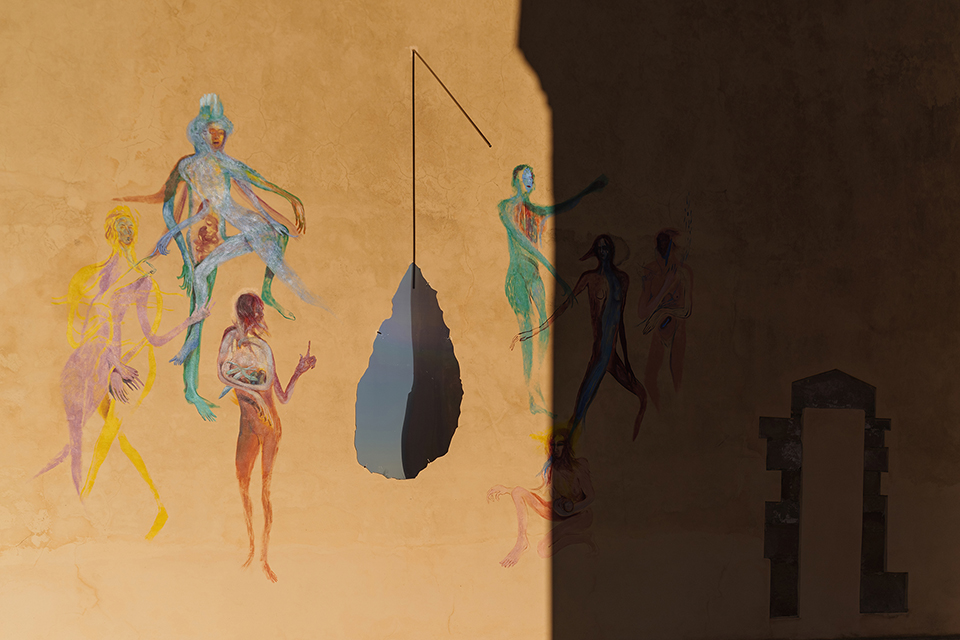
ATPDIARY
RAMPA DI LANCIO: l’arte contemporanea a Peccioli e Legoli in un itinerario immersivo
Testo di /Text by Caterina Fondelli
Legoli, piccola frazione del comune di Peccioli, è la prima tappa del “cammino” di questa mostra: in un’atmosfera cristallizzata nel tempo, il piccolo borgo arroccato, scarsamente popolato, accoglie le opere degli artisti nel suo punto più alto, nella chiesa dei SS. Giusto e Bartolomeo. Dopo un’erta salita, l’esterno dell’edificio religioso presenta le opere di Francesca Banchelli (1981, Montevarchi) e Emiliano Zelada (1979, Roma).
Entrambi gli artisti indagano le coordinate di spazio e tempo, sviluppando un linguaggio condiviso, uno scambio osmotico fra i loro lavori, intensamente condizionati dallo scorrere delle ore. L’ombra del cielo è il dipinto parietale prodotto da Francesca Banchelli per l’occasione sulle facciate laterali della chiesa; un’opera dalle capacità mistiche e coinvolgenti, in grado di traspor- tare verso una profonda riflessione sull’universo, la sua genesi e le sue costanti. Una leggiadra danza che ha come protagoniste le profetesse, osteggiate da secoli nella loro veridicità e ruolo, seduce con colori brillanti e cangianti, modificati dalla luce mutevole delle varie ore giornaliere. Il passaggio del tempo è ulteriormente segnato da una meridiana, collocata dall’artista e responsabile della generazione di un gioco di ombre e corrispondenze con le figure, che rapisce lo sguardo. Al centro della scena, un’amigdala, il riferimento alla pietra scheggiata in grado di produrre vita e evoluzione, ci proietta agli albori della civiltà tramite l’applicazione sul muro di una superficie specchiante. Degno di nota, il tema del femminino analizzato e a cui viene conferito il giusto tributo, il quale emana un vortice vitale senza pari.
ENG.
Legoli, a small hamlet in the municipality of Peccioli, is the first stage of the “journey” of this exhibition: in an atmosphere crystallised over time, the small perched village, sparsely populated, welcomes the works of artists at its highest point, in the church of SS. Giusto and Bartolomeo. After a steep climb, the exterior of the religious building presents the works of Francesca Banchelli (1981, Montevarchi) and Emiliano Zelada (1979, Rome).
Both artists investigate the coordinates of space and time, developing a shared language, an osmotic exchange between their works, intensely conditioned by the passing of hours. The shadow of the sky is the wall painting produced by Francesca Banchelli for the occasion on the side facades of the church; a work with mystical and engaging abilities, capable of transporting towards a profound reflection on the universe, its genesis and its constants. A graceful dance whose protagonists are the prophetesses, opposed for centuries in their truthfulness and role, seduces with bright and iridescent colors, modified by the changing light of the various hours of the day. The passage of time is further marked by a sundial, placed by the artist and responsible for generating a play of shadows and correspondences with the figures, which captivates the eye. At the center of the scene, an amygdala, the reference to chipped stone capable of producing life and evolution, projects us to the dawn of civilization by applying a mirror surface to the wall. Worthy of note, the theme of the feminine analyzed and to which the right tribute is given, which emanates an unparalleled vital vortex.
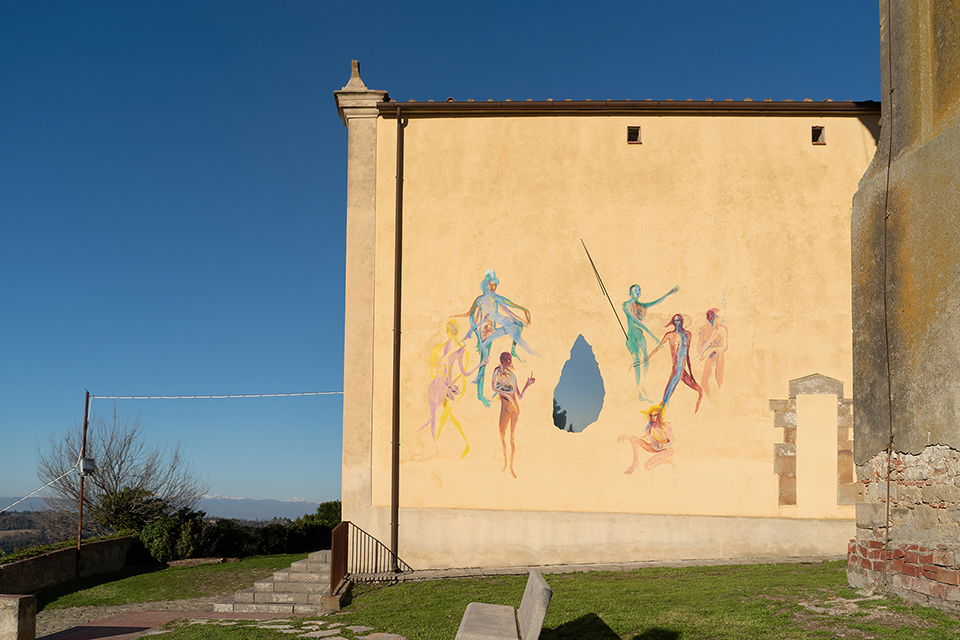
ARTEXT
Sul Primordiale / About Primordial
Testo di /Text by Mirco Marino
Il visitatore è accolto dall’opera di Francesca Banchelli L’ombra del cielo sulla facciata esterna della chiesa rivolta al sole. La sintassi delle figure che in moti ancestrali vivono attorno a una forma centrale richiama per un verso una performatività arcaica, per un altro un assetto formale investigato dai movimenti pre-avanguardisti fine-ottocenteschi. L’istallazione site-specific si compone di tre sostanziali elementi: uno gnomone, una forma centrale in metallo specchiante, e le figure rappresentate intorno a questa.
La meridiana creata sul muro è un’indicazione molto nitida al tempo, o a quello che l’uomo ha chiamato tale. La meridiana ricorda sempre che ciò che l’uomo definisce tempo non è altro che una misurazione del ritmo dei movimenti dei pianeti, una connessione tra terra e cielo che uno strumento dalla struttura elementare rende da invisibile a visibile. Si tratta quindi di una modalità di rappresentazione, che è allo stesso tempo una modalità di presentazione, in quanto la meridiana nel suo complesso si compone dell’oggetto fisico e della proiezione della sua ombra.
Le figure rappresentate in varie tonalità accese sembrano richiamare nuovamente una dimensione temporale, come indicato dalla stessa artista, i soggetti sono Le profetesse bibliche, figure che congiungono il futuro scoperto all’istante epifanico del presente. Queste nella scena sembrano muoversi attorno a ciò che a prima vista nelle sue forme ricorda un falò, un fuoco primordiale, ma che è anche la forma di un’amigdala, la tipica forma a mandorla di un’umanità antichissima, il primo utensile tecnologico, ovvero necessario di una tékhne, termine greco che echeggia nella successiva “ars”, “artis” latina. A mezzogiorno, il sole allo zenit fa sì che l’ombra dello gnomone incontri l’inesistenza visiva del metallo specchiante, suggerendo un allineamento originario al nucleo, di nuovo, tra la terra, il cielo e l’esperienza umana.
ENG.
The visitor is welcomed by the work of Francesca Banchelli The shadow of the sky on the external facade of the church facing the sun. The syntax of the figures that in ancestral motions live around a central form recalls on the one hand an archaic performativity, on the other a formal order investigated by the pre-avant-garde movements of the late nineteenth century. The site-specific installation consists of three substantial elements: a gnomon, a central shape in mirror polished metal, and the figures surrounding it. The sundial created on the wall by the artist, is a very clear indication of “time”, or what man has called such. The sundial always reminds us that what man defines time is nothing more than a measurement of the rhythm of the planets’ movements, a connection between earth and sky that an instrument with an elementary structure makes from invisible to visible. It is therefore a representation mode, which is at the same time a presentation mode, as the sundial as a whole is made up of the physical object and the projection of its shadow.
The figures represented in various bright shades seem to recall a temporal dimension again, as indicated by the artist herself, the subjects are Biblical prophetesses, figures that join the discovered future to the epiphanic instant of the present. These seem to move within the scene, around what at first glance resembles a bonfire, a primordial fire, but which is also the shape of an amygdala, the typical almond shape of an ancient humanity, the first technological tool, or necessary of a tékhne, a Greek term that echoes in the following “ars”, Latin “artis”. At noon, the sun at the zenith causes the shadow of the gnomon to meet the visual non-existence of the mirroring metal, suggesting an original alignment at the core, again, between the earth, the sky and human experience.


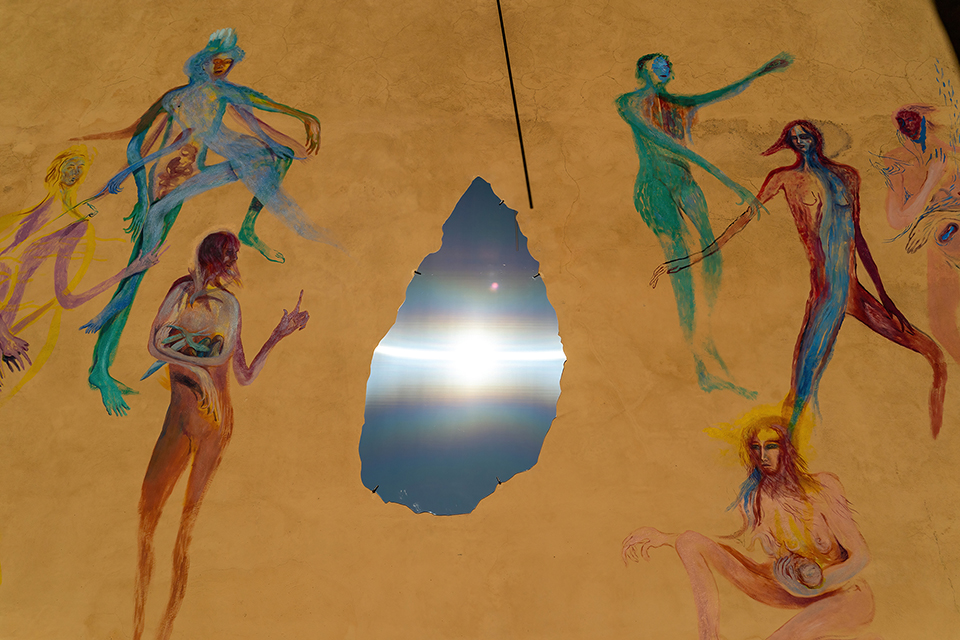
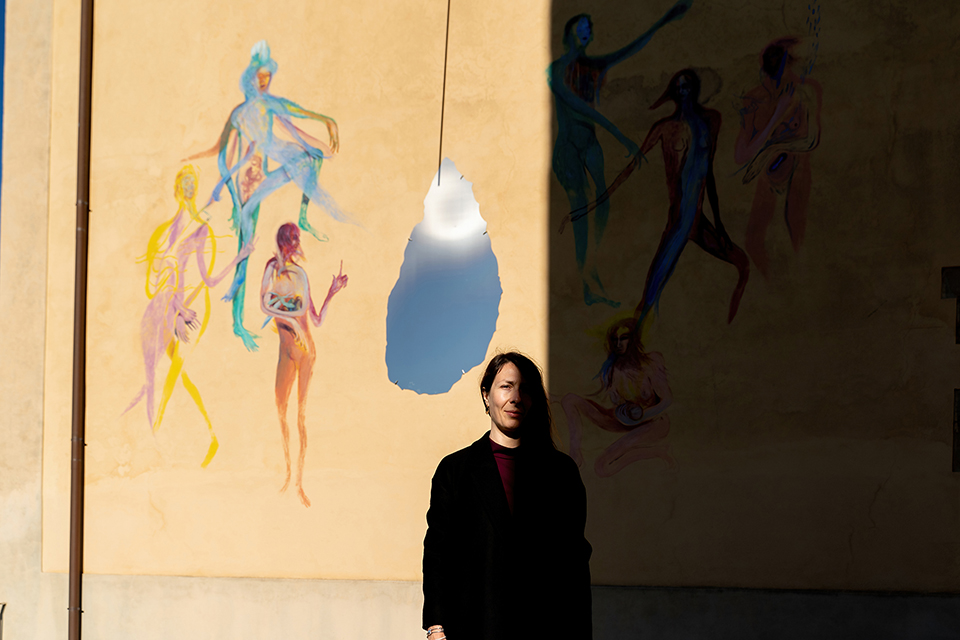
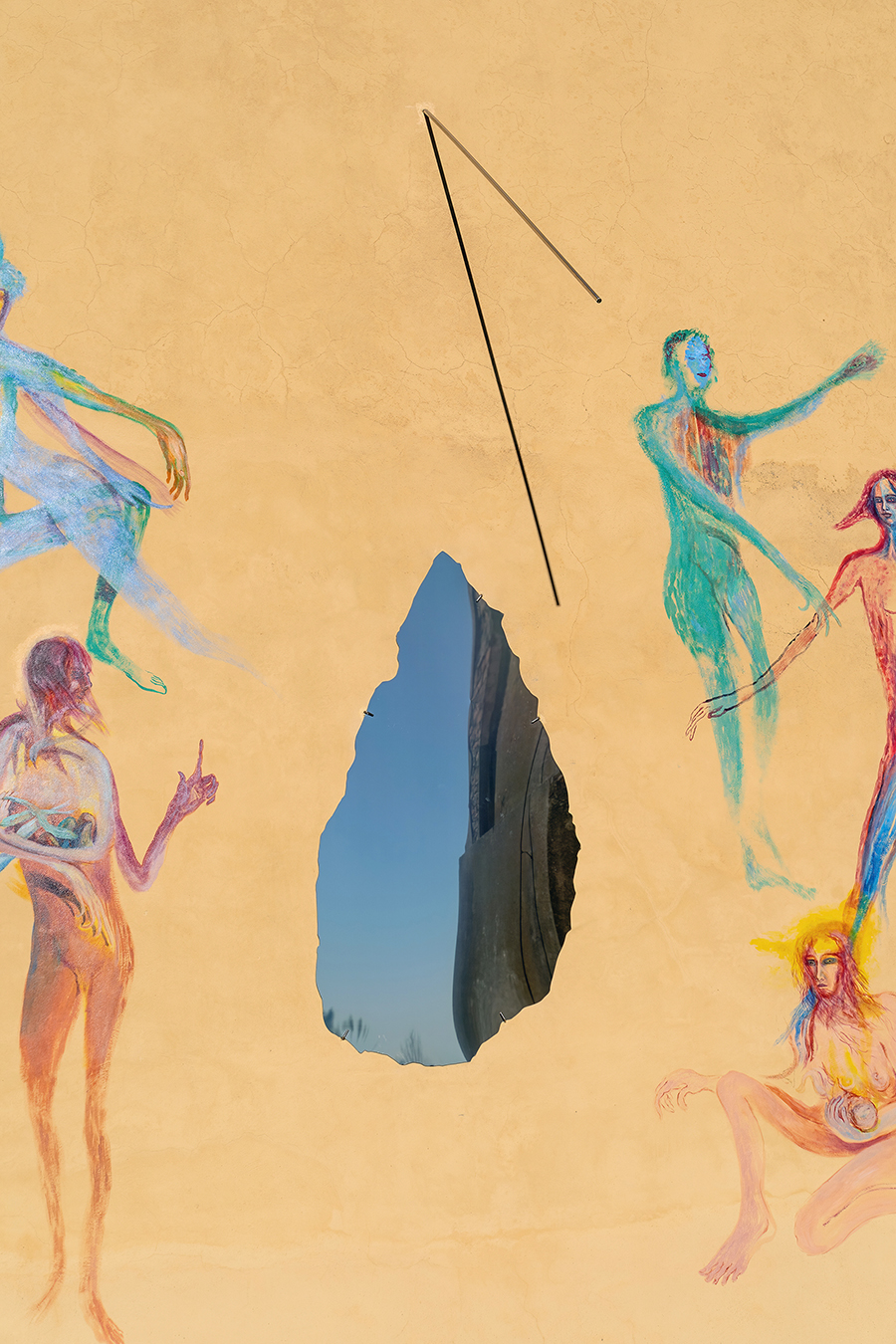

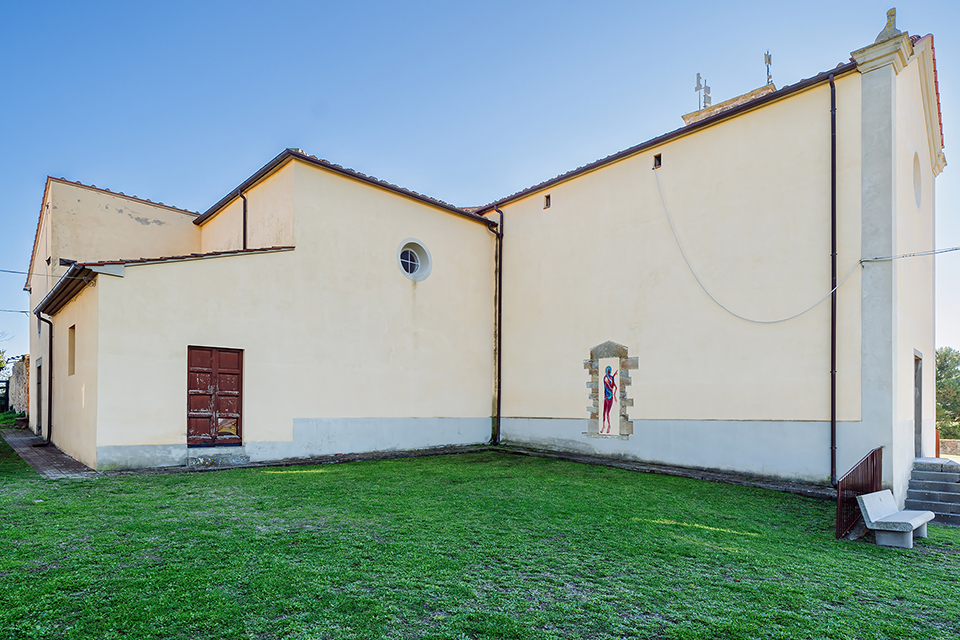
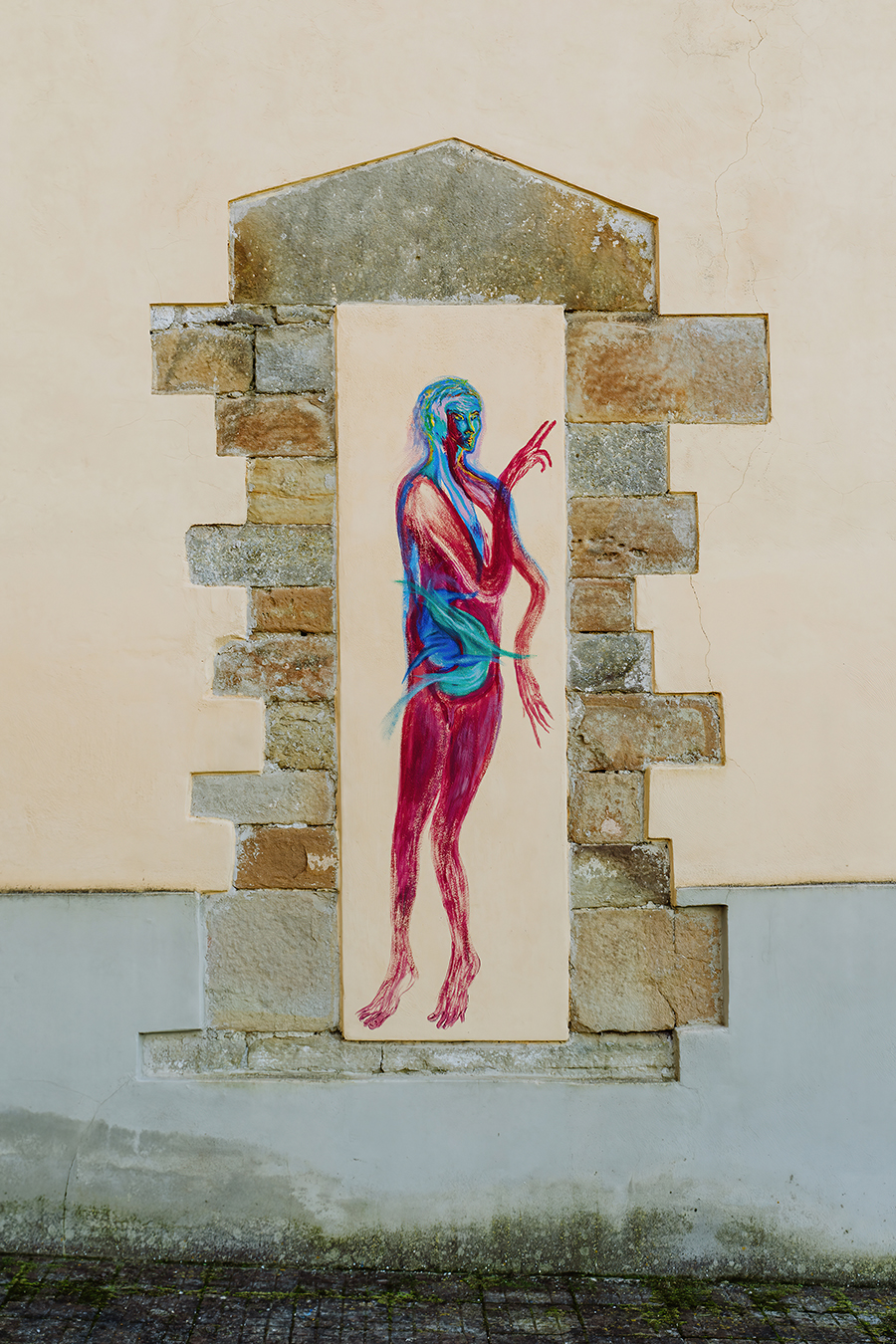

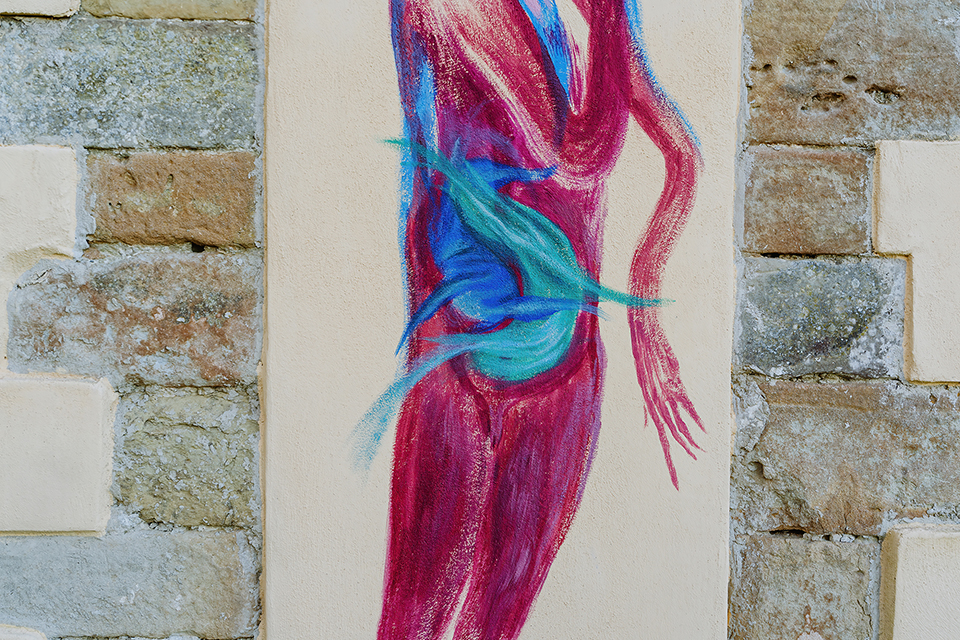
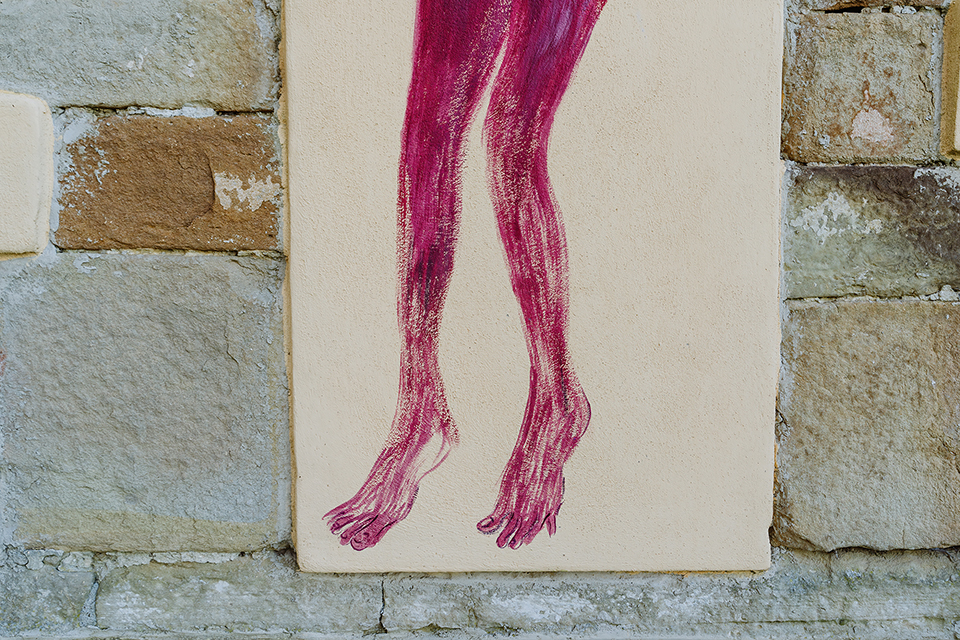
|